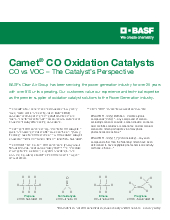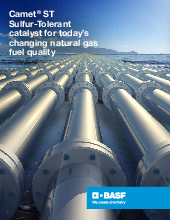Offering innovative solutions that deliver proven results
At BASF, we understand that our customers must not only comply with environmental standards, but also must keep their operations in service, readily and cost effectively. To successfully meet this challenge, BASF offers years of experience developing innovative solutions that deliver proven results. We are committed to providing our customers with cost-effective solutions to the most complex emissions control problems. We are constantly developing new technologies to meet ever more stringent emission requirements to help our customers to be more successful.
CO Catalysts for Power Generation
BASF is the leading oxidation catalyst supplier to the power generation industry. We have been servicing the power generation industry for over 20 years with about 1000 units operating or under construction. BASF customers value our experience and technical expertise as the premier supplier of oxidation catalyst solutions to the power generation industry.
Our breadth of experience encompasses virtually every make, model and turbine configuration. Our R&D, application and project engineering staff expertise ensure maximum performance for both new source applications and replacement catalyst for existing applications. Nearly all of the power generation oxidation catalysts that we have supplied are still running. More than 300 units are six to ten years old and over 200 units are greater than ten years old. No one else in the industry approaches the durability or number of installations of BASF oxidation catalysts for the power generation industry.
Connect with our specialists.

Power plants using natural gas to generate electricity are considered serious point sources of hydrocarbons (HC), carbon monoxide (CO), nitrogen oxides (NOx), and particulate matter. Plant operators are being challenged to meet strict emission standards. For superior treatment of carbon monoxide emissions from these generators, BASF Catalysts Camet® oxidation catalyst systems destroy CO and VOCs from natural gas and oil fired turbines and boilers. These gas turbine catalysts have unmatched experience and performance. In addition, BASF's CatCO™ CO oxidation catalyst technology may be applied for process streams with higher particulate content such as wood fired boilers. These catalysts have been successfully used for many years.
Camet CO Catalysts for Power Generation
BASF Catalysts's Camet® CO catalyst systems destroy carbon monoxide (CO) and volatile organic compounds (VOCs) produced by power generation equipment. As power plant emissions have received increased attention by regulators, power generators have been required to meet ever more stringent environmental regulations. Camet technology offers an efficient, cost-effective program for gas or oil fired turbines and boilers to meet these regulations.
Camet Benefits
Learn more
- The technology has been proven effective by millions of hours of trouble-free performance in the field. Camet-based catalytic converters have a superior conversion efficiency and low-pressure drop.
- The effectiveness of Camet catalysts is a direct result of BASF Catalysts's innovative catalytic core over which the exhaust gases are passed. The core consists of a continuous metal foil that is corrugated, coated with a uniform washcoat containing the catalyst, folded and encased in a steel container. The folded foil's unique herringbone and skew patterns produce the needed turbulence to ensure excellent fluid-to-wall contact, leading to superior conversion efficiency.
- The system provides superior conversion efficiency and enables generators to treat large flow rates of exhaust gas with smaller volumes of highly active catalysts.
- The metal foil substrate provides enhanced catalyst durability with reduced weight. It is rugged and washable. The system also performs effectively in a broad range of operating temperatures
- Camet catalytic systems can be customized to meet the needs of new or retrofit installations, even where space is limited. BASF Catalysts can tailor catalyst composition, cell density and catalyst module shape and dimensions to meet specific requirements.
- Camet catalysts can be configured in individual modules for manual handling or, to reduce service downtime, in complete panels for mechanical loading. Test cores in each unit enable accurate and simple monitoring of the catalyst's efficiency through the life of the product.
CatCO Oxidation Catalysts for Power Generation
BASF's CatCO™ oxidation catalyst is specifically formulated to provide superior abatement of carbon monoxide (CO) from diesel and natural gas engine applications, wood fired boilers and many other process applications, enabling compliance with today's strict environmental standards. Through the process of oxidation, the CatCO catalyst eliminates CO by converting it to less harmful carbon dioxide (CO2).
CatCO Benefits
Learn more
- Reduced emissions of CO by up to 99%
- Ceramic substrate provides high conversion efficiency with low pressure drop
- Can be applied to stand-by or continuous operation engines
- Can be provided in a standard or custom configuration
Camet ST Sulfur-Tolerant Catalyst
Recently, the quality of natural gas fuels has changed dramatically, and the presence of fracked gas, landfill gas, and other acceptable forms of biogas are commonly contained in pipeline gas. The result has been the unpredictable impact on emission catalysts, especially CO/VOC catalysts used in gas turbine applications.
To mitigate the impact of these gases on oxidation catalysts, a complete re-evaluation of catalysts for these applications is required. BASF has re-engineered the traditional CO/VOC catalyst to provide superior performance, even in the presence of higher levels of sulfur. BASF is now offering the patent pending Camet ST Sulfur-Tolerant Oxidation Catalyst to perform in these very unpredictable environments.
Camet ST Benefits
Learn more
- Camet ST can perform with sulfur levels up to 2.4 gr/100 ft3 in the gas stream, over 6 times the normal level of sulfur in natural gas pipelines today, while continuing to meet high levels of CO oxidation.
- High sulfur tolerance
- Excellent stability
Datasheets & Brochures
Camet CO Oxidation Catalysts



